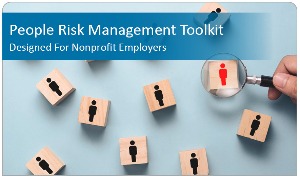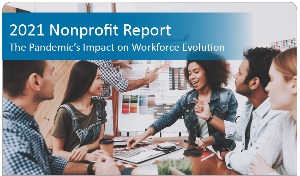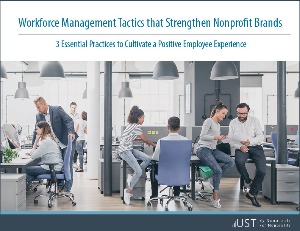
As employers continue to strategize for the future—paving the way for flexible work models and creative retention tactics—many are seeing permanent change take place. UST surveyed more than 400 nonprofit leaders from across the U.S. to uncover the latest sector trends caused by the pandemic and created the 2021 Workforce Trends Infographic.
Download your free copy today to get a sneak peak at what your nonprofit peers had to share about their top workforce issues, COVID’s impact on staffing levels and more.
For only $99, you can also download a copy of the complete 2021 Nonprofit Sector Report to uncover valuable insight on how nonprofits continue to navigate the ongoing challenges that have risen throughout the pandemic.

Hiring new employees can be time-consuming, costly, and stressful. Pre-employment assessments can be useful in determining whether or not a potential new hire is a good fit candidate—with the right skills and mind set for your organization. A proven, scientific way to screen candidates and mitigate the risks of hiring mistakes, incorporating pre-employment testing can be the most effective way to gain a more thorough picture of a candidate’s strengths, skills and personality.
As we know, people-related risks within an nonprofit organization can range from bad hires and misconduct to harassment and lack of diversity in the workplace. To help nonprofit employers strengthen their employee risk management practices—and mitigate the risks that can ultimately affect your bottom line—we created the 2021 People Risk Management Toolkit.
This toolkit includes a performance improvement plan, a risk audit questionnaire, risk management best practice tips and more:
Take the time to thoroughly vet your candidates before hiring. The cost of pre-employment screening is minimal compared to the cost of hiring someone who doesn’t stay. Not to mention, that an employee who isn’t a good fit—for the job or your workforce—can also impact the entire team and overall morale.
If you’re looking for access to more HR-specific articles, templates and checklists? Sign up for a FREE 60-Day Trial of UST HR Workplace today! You’ll also gain access to live HR certified consultants, 300+ on-demand training courses and an extensive compliance library.

Are you curious to discover how nonprofits have pivoted strategies in response to COVID-19 and how this pandemic is causing permanent change across the sector? With over 400 survey respondents—representing a wide variety of nonprofits from across the U.S.—this report unveils the pandemic’s impact on workforce evolution and illustrates how the sector withstood the hardships caused by the crisis.
Download the report to learn:
This report will provide valuable insight on how nonprofit organizations are navigating the ongoing challenges that have arisen throughout the pandemic. For only $99, download your copy of the 2021 sector report today!

One of the biggest challenges nonprofits are faced with is the “great resignation” sparked by the pandemic—where employees are burnt out and pursuing new jobs that better align with their evolving priorities. In order to stay competitive in today’s job market, nonprofit leaders must reinvent their recruitment tactics, work-life balance initiatives and employee engagement strategies.
Don’t miss your chance to download a free copy of UST’s latest eBook, Workforce Management Tactics that Strengthen Nonprofit Brands, to discover 3 key strategies that can help your nonprofit create (and sustain) a resilient workforce.
In this eBook, you’ll discover:
This eBook will help you uncover new strategies that will encourage your current (and future) workforce to carry out your mission for years to come.

Turnover is a natural part of any nonprofit organization’s life cycle, and employee offboarding should be handled with the same degree of importance as onboarding a new employee. An offboarding plan offers an opportunity for communication and manage change, to help preserve and improve your employer brand and to generate good faith with the departing employee. There can be many moving pieces involved with a termed employee and clear offboarding procedures help manage the expectations of all parties involved.
When done correctly, the employee offboarding process can offer key management insights and reveal hidden internal issues. From a management point of view, the focus is to address issues at an organization level. Whereas, employees are faced with small issues that aren’t always noticed by managers or the executive team. Not giving attention and time to these small and recurring issues can lead to larger issues which could then impact the productivity of the organization.
Here are some best practices when creating an efficient and smooth employee offboarding process:
1) Learn why the employee is leaving: Maybe the employee wasn’t a long-term fit for your company culture, perhaps they came across a career-changing opportunity, or they weren’t a fit to handle growth gracefully. Regardless of the reason, organizations need to first understand the reason why an employee wants to leave and have a clear plan in place to handle each type of exit. Having the appropriate policies and procedures in place to handle any and all offboarding reasons are key for orchestrating a smooth departure.
2) Conduct a smooth offboarding: A crucial aspect of a good employee offboarding process is to treat employees warmly, regardless of the reason behind their departure. Creating a positive farewell will encourage employees to speak to others positively about their experience which in turn, increases the organization’s brand value. Taking the opportunity to engage departed employees will help with talent acquisition and managing the reputation of the organization’s brand.
3) Ask for feedback: When an employee leaves, it can be a valuable opportunity to collect insightful turnover data. During the exit interview, the employee can offer honest feedback about the organization since they are no longer reliant on this job for financial means. When an employee expresses their desire to leave, sending them an exit interview survey can help organizations uncover areas of opportunities that need to be addressed to improve employee engagement and productivity.
4) Avoid decreases in productivity: When an employee departs, day-to-day activities overseen by this employee will be interrupted or possibly put on pause—resulting in a decrease in productivity. Cross training with current employees can prevent a dip in productivity, such as, transferring process knowledge, document procedures and responsibilities, and login credentials for business tools.
Depending on the reason for the employee’s departure, exit interviews are an opportunity to collect important insights to improve your current offboarding strategy. The complexities involved in offboarding make saying “goodbye” to employees a challenging task—which is why consistency is the key to a successful exit interview. With the right tools in place, organizations have the ability to standardize the complexities involved in employee offboarding and help you part ways in the most efficient way.

UST just released the latest edition of our Quarterly Nonprofit Digest. This quick reference guide highlights key findings from last quarter’s most popular content—which focused on innovative nonprofit sustainability strategies to help employers thrive in these ever evolving times.
If you’re a nonprofit leader, download your free copy of the Q2 quarterly digest to discover essential strategies for:
You’ll also gain access to helpful checklists, people risk management templates and best practice tips to help you plan (and execute) a successful virtual event.
To get more nonprofit-exclusive content, webinar invitations and sector insights delivered straight to your inbox, sign up for UST’s eNewsletter today.

In the latest rendition of UST Live, we were joined by guest moderator, Jenny Berg of the Leadership Council for Nonprofits, where we welcomed thought leaders from across the U.S. with expertise in DEI best practices. In this session, the panel discussed innovative strategies for identifying (and prioritizing) board diversity and inclusion practices—that in turn can help advance your mission in such a way that is both equitable and more appealing to donors, potential job candidates and the communities you serve.
Watch now to discover:
Upcoming UST Live Webinars: This webinar series was designed to equip nonprofits with the strategies and resources they need to survive (and thrive) in a constantly evolving environment. Be on the lookout for our next UST Live sessions—scheduled for June, September, and December—where we’ll discuss strategies surrounding nonprofit sustainability, HR and compliance and leadership development.

With the rise of smartphones, social media and other digital channels, nonprofits now have more tools available to them for engaging donors than ever before. The issue that comes with having so many ways to donate, is that it can be difficult to pinpoint which engagement techniques are most effective for engaging donors. Most nonprofits know that the main form of donor engagement is making a donation, however, there are quite a few ways to engage with those individuals any time they support or directly interact with the organization. Any opportunity to interact with a donor is a chance to strengthen your relationship with them, which could naturally result in more donations.
To show appreciation for your donors, it’s crucial to develop nonprofit donor engagement strategies that strengthen the relationship between you and your supporters. If you’re looking for best practices to boost your donor engagement, here are four key techniques that can help your nonprofit raise more money and improve your donor retention rate:
1) Create Personal and Genuine Messaging: Engaging your donors requires a personal and authentic approach. Take the time to learn about your donor’s interests as individuals and be transparent when you have interactions with them. Establishing trust with your donors will often result in their willingness to support your mission and reaching your donors on a more personal level, can allow for more opportunities to create personalized engagement strategies down the line.
2) Utilize the Benefits of Software: It’s a challenging task to keep up with hundreds, thousands, or even tens of thousands of donors. Successful communication with your donors requires individualized approaches and the information necessary to make it possible to make those individualized approaches come to life. This is where having a donor database can be a great resource—a nonprofit CRM—a tool built to help nonprofits track all aspects of their donor relationships.
3) Offer and Implement a Membership Program: A membership involves the donor giving fees or dues to a nonprofit in exchange for member status and the rights, perks or benefits that are included in the membership. The frequency and type of engagement opportunities you offer members will depend on your organization, but the possibilities can be endless. For example: host member only events, special volunteer opportunities or a member ONLY newsletter.
4) Create a Text Communication Option: Seeing as texting is such a prevalent communication method, organizations need to take advantage of this huge engagement opportunity. There are many services that enable nonprofits to establish a text marketing list, allowing your organization the ability to send a mass text message to all donors who subscribed to this list.
Looking for opportunities to engage with your donors authentically and honestly will go a long way in ensuring donors donate time and time again. Take the time to deeply understand why the donor supports you and deliver on their expectations. Start seeing a donation as a part of a relationship, not a one-off business transaction. This way you begin to deepen relationships with people that support what you do, rather than just treating them as just donors. Show gratitude to your donors, invite them to engage in other ways than donating, share with them why they matter, and get to know them on a more personal level.

Nonprofits across the country were forced to pause, pivot and make remarkable changes to their in-person events last year due to the unprecedented circumstances of COVID-19. As organizations continue thinking about their in-person vs. virtual strategies, the hybrid future of events is taking form—changing the events landscape for years to come.
Virtual events offer the best combination of brand exposure and the digital engagement people crave. Whether your event is large or small, one day or one week, we’ve compiled some of the top Virtual Event Best Practice Tips to help you navigate the many considerations involved in planning (and executing) a successful virtual event.
Want access to more nonprofit-specific tips, toolkits and webinars? Sign up for our nonprofit eNewsletter today!

When looking at the current work environment, we can see that it requires flexibility, being open to new skills and navigating new ways of working. And depending on where your nonprofit organization is in the digital transformation, there may be a lot to do in preparing your employees for the future of work. More and more organizations have been forced to transition from the manual, hands-on legacy systems to using the cloud—moving employees toward a data-driven culture, embracing machine learning and a number of other technologies.
Here are five tips to help guide your nonprofit organization towards a greater digital transformation in an ever-evolving work and business environment:
1) Recruit for the future: At least a portion of your current workforce will have moved on to other employment in the next 5 to 10 years, so think about succession planning now. Knowing the realities of modern business—it pays to think about how you’ll fill certain positions moving forward—you’ll likely want to focus on recruiting employees who have the skill sets that you need for future roles.
2) Offer upskill, re-skilling and transfer skill opportunities: When employees demonstrate strong aptitude and interest in certain technology, it would be smart to encourage and develop that skill set. Along with offering training for all employees, it’s important to consider the employees that have been loyal to your company may need some re-skilling. Also, don’t forget that employees who will be retiring can offer valuable skills to pass on the next generation. While we live in a world where technology is increasingly required for every aspect of work, soft skills like communication, time management and professionalism will always be needed in the workforce.
3) Become more flexible: Technology isn’t just there to draw you closer to your customer, although that’s a big part of why we’ve embraced it. Being open to other ways that technology can allow for a more flexible work environment, including a new concept of the “workplace” itself, can be very beneficial for your workforce. Let your employees know that these benefits are coming due to the latest technology your organization is adopting.
4) Set guidelines: As we develop larger online footprints, creating content and being active on social channels, it’s important to consider and define where your company stands on personal expression and social media. The line between your employee’s online activity and physical world is continuing to blur. A comment left on Twitter could easily get back to your employer and it may not be received well or taken lightly, based on the context. Take time to think about how you encourage personal expression in the digital world and how it could potentially impact your organization’s brand.
5) Prepare a path for employees to follow: Guide your employees, be a leader. Employees may already have reservations or concerns about how new technology could impact their place in the organization. Your employees need your empathy and support—talk to them about changes to come and listen to their concerns.
While it’s impossible to know every aspect of what the future of work will look like at your organization, the above tips can be helpful in offering guidance on how to prepare your employees for staying skilled and to maintain a productive work environment. Business leaders can take the time to plan for the future in which training and learning will be the focus however, no one knows exactly what the future of the workforce will hold.

UST maintains a secure site. This means that information we obtain from you in the process of enrolling is protected and cannot be viewed by others. Information about your agency is provided to our various service providers once you enroll in UST for the purpose of providing you with the best possible service. Your information will never be sold or rented to other entities that are not affiliated with UST. Agencies that are actively enrolled in UST are listed for review by other agencies, UST’s sponsors and potential participants, but no information specific to your agency can be reviewed by anyone not affiliated with UST and not otherwise engaged in providing services to you except as required by law or valid legal process.
Your use of this site and the provision of basic information constitute your consent for UST to use the information supplied.
UST may collect generic information about overall website traffic, and use other analytical information and tools to help us improve our website and provide the best possible information and service. As you browse UST’s website, cookies may also be placed on your computer so that we can better understand what information our visitors are most interested in, and to help direct you to other relevant information. These cookies do not collect personal information such as your name, email, postal address or phone number. To opt out of some of these cookies, click here. If you are a Twitter user, and prefer not to have Twitter ad content tailored to you, learn more here.
Further, our website may contain links to other sites. Anytime you connect to another website, their respective privacy policy will apply and UST is not responsible for the privacy practices of others.
This Privacy Policy and the Terms of Use for our site is subject to change.
UST maintains a secure site. This means that information we obtain from you in the process of enrolling is protected and cannot be viewed by others. Information about your agency is provided to our various service providers once you enroll in UST for the purpose of providing you with the best possible service. Your information will never be sold or rented to other entities that are not affiliated with UST. Agencies that are actively enrolled in UST are listed for review by other agencies, UST’s sponsors and potential participants, but no information specific to your agency can be reviewed by anyone not affiliated with UST and not otherwise engaged in providing services to you except as required by law or valid legal process.
Your use of this site and the provision of basic information constitute your consent for UST to use the information supplied.
UST may collect generic information about overall website traffic, and use other analytical information and tools to help us improve our website and provide the best possible information and service. As you browse UST’s website, cookies may also be placed on your computer so that we can better understand what information our visitors are most interested in, and to help direct you to other relevant information. These cookies do not collect personal information such as your name, email, postal address or phone number. To opt out of some of these cookies, click here. If you are a Twitter user, and prefer not to have Twitter ad content tailored to you, learn more here.
Further, our website may contain links to other sites. Anytime you connect to another website, their respective privacy policy will apply and UST is not responsible for the privacy practices of others.
This Privacy Policy and the Terms of Use for our site is subject to change.